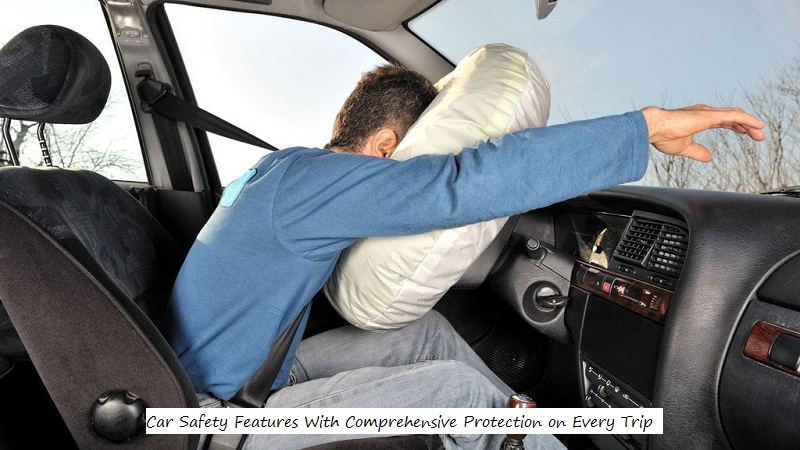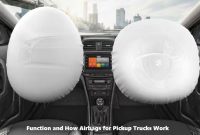Safety is a top priority in the automotive industry. Along with the development of technology, today’s cars are equipped with various safety features that aim to protect drivers, passengers, and other road users. Car safety features are divided into two main categories, namely active safety features and passive safety features.

Active Car Safety Features
This feature works before an accident occurs. The goal is to prevent or minimize the risk of incidents while driving. Here are some common active safety features:
Anti-lock Braking System (ABS)
This system prevents the wheels from locking during sudden braking. As a result, the car can still be controlled even if you brake hard on slippery or emergency roads.
Electronic Stability Control (ESC)
Electronic Stability Control (ESC) plays a role in keeping the car balanced when having to make sudden movements, such as when turning to avoid danger on the road. This system helps the driver maintain control of the direction of the vehicle so as not to skid or lose control. This technology works automatically by adjusting the braking and power distribution, so that the car stays on track and does not skid easily.
Traction Control System (TCS)
TCS prevents tire slippage when the car accelerates, especially on slippery or uphill roads. This technology ensures optimal wheel traction.
Lane Departure Warning (LDW)
A safety feature that functions to provide a warning when the vehicle starts to leave the lane without a turn signal. This system uses sensors or cameras to monitor the position of the car in relation to the road markings, then emits a sound or vibration to remind the driver to return to the original lane.
Blind Spot Monitoring (BSM)
This feature functions to recognize the presence of other cars in areas that are difficult to see from the rearview mirror, then provides a warning signal when there is an intention to change lanes.
Rear Cross Traffic Alert
When the car is reversing from parking, this system identifies vehicles passing from the side and warns the driver.
Adaptive Cruise Control (ACC)
When the vehicle in front slows down, the system automatically reduces speed to maintain a safe distance and ensure conditions remain under control.
Benefits of Active Safety Features
Here are some of the benefits:
- Increase driver alertness
- Prevent collisions or accidents
- Reduce the risk of human error
- Assist drivers in emergency situations
- Provide a greater sense of security during the trip
Passive Safety Features
This passive safety feature functions when or after an accident occurs to reduce the impact of injury. Among them:
Airbag
When the sensor detects an impact, the airbag will immediately inflate in a very short time, which is only a few milliseconds. This process is carried out to minimize the risk of serious injury to passengers by providing additional protection quickly. The general position is on the steering wheel, dashboard, side of the door, and sometimes on the knees or head. Its function is to protect the body from direct impact with the inside of the car.
According to the explanation from the Teknologi Populer video, the airbag will inflate automatically when the vehicle is in a collision. The sensor will recognize a collision and automatically activate the safety system that has been prepared. This feature is designed to protect important body parts of the driver and passengers. The location of the airbag in each vehicle can vary depending on the design and type of car.
Three-Point Seat Belt with Pretensioner
The seat belt remains the most basic but vital tool. Pretensioners automatically tighten the belt when a collision occurs, so that the body remains in a safe position and reduces sudden movements.
Car Frame Structure (Body Impact Absorption Zone)
The car frame is designed with a crumple zone that can absorb collision energy and channel it away from the passenger cabin, reducing the risk of serious injury.
Headrest
Although it looks simple, the headrest has a crucial function in preventing neck injuries during a rear-end collision. This device helps to restrain sudden head movements, reducing the impact of the collision and minimizing the risk of damage to the neck.
ISOFIX (International Standard Baby Seat Hook)
This system allows the baby seat to be firmly and stably attached to the car seat without relying on the seat belt, providing optimal protection for children.
Side Impact Beam
The reinforcing beam inside the car door is designed to absorb and distribute energy during a side collision.
The Importance of Passive Safety Features
Some of the benefits of passive safety features:
- Protects passengers when a collision occurs
- Reduces the severity of injuries
- Maintains a safe body position
- Protects children and toddlers in particular
- Provides peace of mind while driving
Car safety features are an important component that should not be ignored. This technology continues to develop to create a safer and more comfortable driving experience. Before buying a vehicle, be sure to check the completeness of its safety features because on the road, safety is everything. /satya



